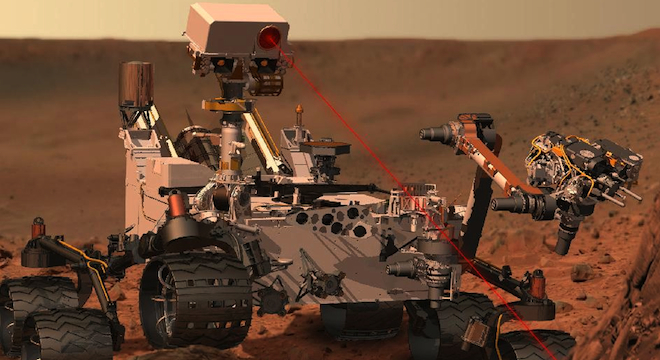After a picture perfect blast-off on Saturday, NASA’s Mars Curiosity rover is now well on its way to the Red Planet for an expected landing in August 2012.
When it reaches the surface, the rover will begin the most comprehensive survey of the Martian geology to date, including searching for evidence that Mars supported, or can support, life.
But to do that, the rover will be relying on a buffet of scientific instruments, including “ChemCam,” the Chemistry and Camera instrument, a combination spectrometer/laser developed by Los Alamos National Laboratory that fires an ultra-precise, extremely high-powered invisible laser beam designed to vaporize Martian rocks and soil samples a millimeter at a time for further analysis of their composition. The resulting plasma cloud left in the wake of the vaporized matter is then recorded by the spectrometer’s telescope.
“ChemCam is designed to look for lighter elements such as carbon, nitrogen, and oxygen, all of which are crucial for life,” said Roger Wiens, principal investigator of the MSL mission’s ChemCam team, in a Los Alamos National Laboratory news release. “The system can provide immediate, unambiguous detection of water from frost or other sources on the surface as well as carbon–a basic building block of life as well as a possible byproduct of life. This makes the ChemCam a vital component of Curiosity’s mission.”
Wiers first came up with the idea for the device after seeing a colleague demonstrate a desktop version in 1997.
Now, tech specs published by the Los Alamos National Laboratory on Monday reveal that ChemCam’s beam can reach 10 megawatt intensity, on par with that of Boeing’s Chemical Oxygen Iodine Laser (COIL), the signature anti-missile weapon aboard the Defense Department’s Airborne Laser Test Bed, which successfully engaged and destroyed a boosting missile target in a February 2010 test.
However, as The Register points out, the ChemCam is an even more remarkable device given how comparatively small and light it is. Whereas the COIL device is on the order of 1.7 tons, so large as to necessitate being carried aboard a Boeing 747-400F, the entire Mars Curiosity rover weighs only 1 ton, including all of its 10 instruments, and the weight of the other equipment, such as its wheels and body. That said, Curiosity is 10 times the weight of each of the three previous Mars rovers.
But the laser provides a huge boost in productivity over those other rovers, Spirit, Opportunity and Soujourner. Unlike Spirit and Opportunity, which had to break apart the rocks for analysis, taking two or three days to do so, Curiosity’s ChemCam can blast the rocks from 25 feet away.
Not only that, but Curiosity’s ChemCam can also produce rapid-fire beams over a single area or multiple areas, greatly increasing the utility of the device and the possible sample sizes. The team expects ChemCam to be blasting and analyzing 12 or more samples every day on Mars.
But it isn’t suitable for being used as a weapon as it only vaporizes a small area and the pulses last less than 5 nanoseconds and have a low frequency, between 1 and 10 hertz.
“The trick is very short bursts of the laser,” Wiens said in an earlier release. “You really dump a lot of energy onto a small spot — megawatts per square millimeter — but just for a few nanoseconds.”
Over 30 scientists from Los Alamos worked with colleagues form French space institute Research Institute of Planetary Astrophysics and the French space agency National Center for Space Studies to design and develop the instrument. The technology behind it, though, was primarily devised at Los Alamos.
Called laser-induced breakdown spectroscopy (LIBS), the system relies on an infrared laser and has been used for such Earth-bound purposes as cancer detection and determining the composition of objects in “extreme environments,” including the sea floor and inside nuclear reactors, according to Los Alamos.
With such an advanced laser onboard, its no wonder NASA’s Curiosity openly boasts of the ChemCam. “Who’s got six wheels, a laser and is currently en route to the Red Planet? Me. I’m Curiosity, aka the Mars Science Laboratory,” the rover’s Facebook page says. There is even a whole separate website dedicated to the ChemCam.
We’ve reached out to Los Alamos for more information on their ChemCam laser and other projects and will update when we receive a response.









